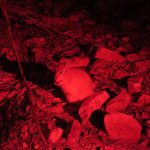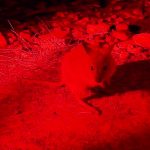RUFOUS HARE-WALLABY
Sharon: Some remote outback feral-proof enclosures have been built to captive breed some of our endangered Critters, and Rufous Hare-wallabies were one of them. So after some enquiries we set off to visit the enclosures on a night walk. This is what we saw:
The Rufous Hare-wallaby (Mala): A Story of Survival in the Heart of Australia
In the golden light of dusk, as the heat of the day fades across the red sands and spinifex plains, a small, shadowy figure emerges. This is the Rufous hare-wallaby—known to many as the Mala—one of Australia’s most remarkable yet endangered marsupials.
Vivid Description: Meeting the Mala
Picture a creature no bigger than a loaf of bread, with exquisitely soft, rufous fur blending seamlessly with the ochre landscape. Its large, alert ears twitch at the faintest sounds, and its powerful hind legs are primed for swift, bounding hops. The Mala’s delicate nose twitches as it sniffs the air, searching for the scent of fresh grass or seeds, its small paws moving silently over the sandy soil.
- Size: 800g–1.8kg, about 30–40cm in body length
- Tail: 25–35cm, helping with balance as it hops
- Fur: Reddish-brown, providing camouflage
- Movement: Quick, agile hops reminiscent of a hare
Habitat and Adaptations
Once widespread across central and western Australia, the Mala now survives in isolated pockets, such as the Tanami Desert and protected enclosures. Imagine the endless stretch of spinifex grass, sharp and resilient, interspersed with low shrubs and sandy burrows. The air is dry, carrying the subtle scent of earth and grass.
- Habitat: Spinifex grasslands and shrublands
- Adaptations:
- Efficient water conservation
- Nocturnal foraging to avoid daytime heat
- Shelters in burrows or dense vegetation during the day
A Night in the Life
As darkness falls, the Mala emerges, its senses heightened. The cool air brushes its fur as it quietly nibbles on grasses, seeds, and leaves—especially favouring the tough, spiky spinifex. Each mouthful is gathered with care, the Mala’s diet shaped by the challenging environment.
- Diet: Herbivorous, feeding on grasses, seeds, leaves
- Foraging: Nocturnal, reducing water loss
Life Cycle and Family
The Mala’s life is shaped by the rhythms of rain and drought. When conditions are right, breeding can occur at any time of year. A single joey, blind and tiny, is born after about 30 days, crawling into its mother’s pouch. Safe there, it grows, nourished and protected for several months before venturing into the world.
- Breeding: Year-round, influenced by rainfall
- Gestation: ~30 days
- Development: Joey remains in pouch, then stays close until weaned
Conservation: Challenges and Hope
The Mala’s story is one of resilience but also of urgent need. Once abundant, it now faces threats from habitat destruction, introduced predators like foxes and feral cats, and competition with invasive rabbits. Conservationists have responded with determination, creating safe havens in predator-free enclosures and restoring habitats.
| Threats | Conservation Actions |
|---|---|
| Habitat loss | Habitat restoration |
| Predation (foxes, cats) | Predator control programs |
| Competition (rabbits) | Translocation to safe areas |
Cultural Significance
For Aboriginal groups of central Australia, the Mala is far more than a marsupial. It is a creature woven into traditional stories and ceremonies, symbolising resilience and the deep connection between people and land. Indigenous ranger groups play a vital role in Mala conservation, blending ancient knowledge with modern science to protect this precious animal.
The Sensory World of the Mala
- Sight: Watch its soft fur ripple as it moves through moonlit grass.
- Sound: Hear the gentle rustle as it forages, the quiet thump of its hops.
- Touch: Imagine the fine, velvety texture of its fur, perfectly suited for sheltering from the desert’s extremes.
- Smell: The earthy tang of spinifex and dry sand, the Mala’s ever-present backdrop.
Why the Mala Matters
Every Mala is a symbol of Australia’s unique natural heritage—a living thread in the fabric of the outback’s story. Its survival depends on our choices and actions. By supporting conservation efforts and respecting the knowledge of Indigenous custodians, we can help write a new chapter of hope for the Mala and the landscapes it calls home.
Conclusion
The Rufous hare-wallaby’s journey is a reminder of nature’s fragility and resilience. As we learn from the Mala—its quiet endurance and its cultural significance—we are called to cherish and protect the wild places and creatures that define Australia. Their story is also our responsibility.
Let the whisper of the Mala at dusk inspire us all to care for the wild heart of Australia.



